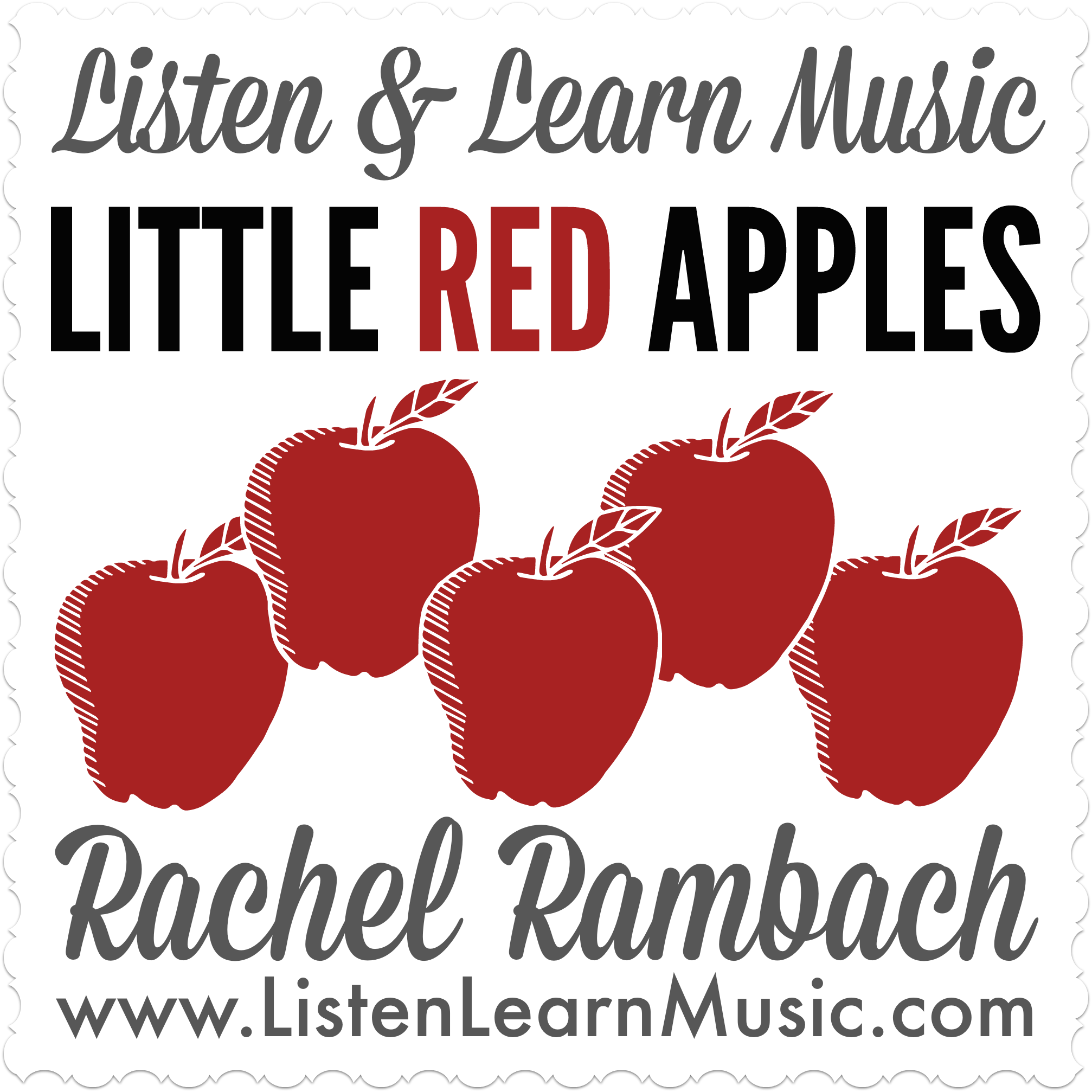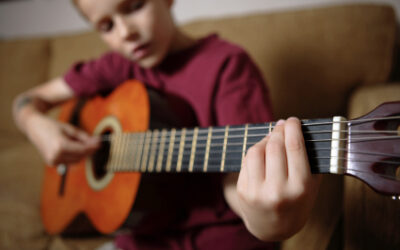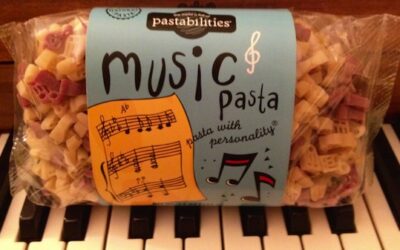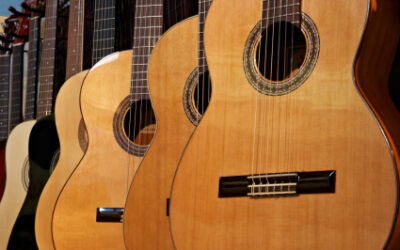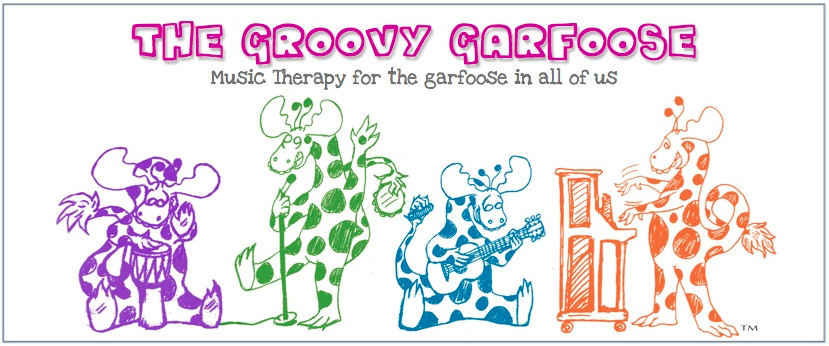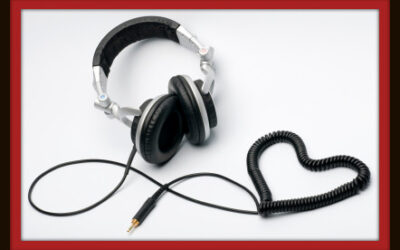Free Download: “Little Red Apples”
This is one of many counting songs I’ve written, which focuses on counting both up to 5 and down from 5. I created simple apple visual aides (using red construction paper and then laminating) which my students can then manipulate as we count.
Click here to download the mp3 and lyrics/chords.
P.S. If you want access to my entire collection of over 200 songs (mp3, lead sheet, and instrumental track), videos, tutorials, and visual aides, plus ALL new releases from Listen & Learn Music, consider joining me over at Listen & Learn Plus!
Student Spotlight: “O Christmas Tree”

I love everything about the holidays: giving gifts, singing Christmas songs, the general cheeriness of the season. But putting up my Christmas tree and seeing it all lit up at night is probably what I look forward to most every year. Matthew agrees with me on that, which is why he chose to include “O Christmas Tree” in his holiday repertoire.
Although he has been taking piano lessons from me for many years (he was actually the first official Music Therapy Connections student!), Matthew only recently began taking voice lessons here at the studio as well. This 5th grader is on his way to becoming quite the musical double-threat:
There are only a few days left before my studio closes for the holiday break. I’m sure going to miss hearing my students’ sweet voices singing the sounds of the season!
Part 2: Using the Guitar and Music Education to Enhance Childrens’ Cognitive Development
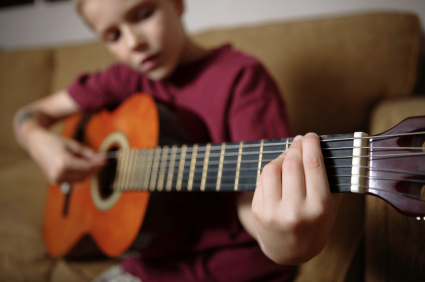
This is the second of a two-part article series by guest author Aaron Schulman. You can read part one here.
In the previous article of this series, we discussed the importance of music in developing cognitive abilities in young children. Now let’s take a look at some practical ways or methods to implement the process in your own home. Whether your goal is to simply enrich your child’s learning abilities with music, piano or guitar education, or whether you aspire to help him or her become the best beginner acoustic guitar player he or she can be, these ideas can help set a normal and quality foundation.
The age of the child is of great importance to how you teach a musical instrument. As a child grows, so will his or her attention span. Studies show that simple instruments, such as a keyboard or hand drum, can be played by nearly any child who can follow simple directions. However, a very young child would not have organized lessons, nor would the teaching last long. It is important that the first lessons be fun and stimulate your child’s interest in music.
As the child matures, lessons can last longer and become more structured. A rewards system, such as short breaks with a special, healthy snack in the middle and end of the lesson, may work well with younger children. For older children, they will be able to see the progress they are making as a reward in and of itself. Intrinsic motivation can be built up as a child begins to get satisfaction from the sheer process and enjoyment of learning music.
But for a child at any age, time spent with a parent learning about an instrument is valuable. For example, you may show a drum to a one year old, and teach them how to say the word drum. This will help develop interpersonal and language skills. As the child learns to tap out a rhythm, they are learning musical and kinesthetic (body movement) skills. For an older child, figuring out tempo and patterns and learning to read sheet music can help develop mathematical skills and self-confidence.
Make sure to encourage your child in his or her process, and remember that each child is an individual who learns his or her own way. Even siblings will not learn at the same pace (so be sure to adjust the details of the learning process to suit individual personalities). A younger child may learn a certain instrument more quickly than an older child. One twin may have an ear for rhythm while the other does not. That’s okay and should be expected as the “norm”. Each child will have differing strengths in each of the seven Multiple Intelligences (learning styles.)
As you may recall from the first part of this series, these seven areas are:
- Linguistic (verbal and written communication)
- Logical-mathematical (logical analytical skills)
- Visual (spatial-creative thinking in abstract ways or dimensions)
- Bodily-kinesthetic (using coordinated body movements to accomplish tasks)
- Musical (musical talent and ability)
- Interpersonal (development ability to work well with others)
- Intrapersonal (development of internally oriented tendencies)
A child’s intelligence cannot be measured by focusing on one single area, rather all areas and learning styles must be considered for a complete assessment. And, don’t forget that it is more important to stimulate your child’s brain development with structured variations and challenges in the lessons in music rather than to simply make sure that the child perfects every lesson within a specified time.
The choice of instrument is important as well. Your toddler or young child will not be able to handle a full-sized guitar or even a ¾ size guitar with effectiveness (it may cause more frustration at too early an age as well). With a younger child, a keyboard or piano is a good place to start. As the child grows, he or she may “graduate” to a child-sized mini guitar. The lessons they learn on these smaller instruments will follow them into adulthood and perhaps even promote a lifelong passion for music.
All in all, even if your youngster doesn’t grow up to be a modern day Mozart, you can rest assured that the musical training he or she received as a child helped develop learning styles and skills that will be utilized throughout life.
About the Author: Aaron Schulman developed a passion for playing acoustic guitars over twenty years ago, and continues to enjoy playing, teaching, studying the guitar and writing guitar reviews, like a recent one on the Baby Taylor. Aaron has made it a personal goal to help others find their own “fit” in an acoustic guitar within their personal budget and goals. You can read more reviews, including one on the Taylor 110 e at Strumviews.com.
Sunday Singalong: Grandma Got Run Over By a Reindeer
The other day as I was getting ready for work, this song came on the radio. Before I knew it, there I was — performing the accompanying show choir moves I learned in middle school. 15 years ago.
I posted about it on Facebook, only to find out that I wasn’t the only former Generalette (of the Grant Middle School Generals & Generalettes, G&G for short) who still busted out these moves from time to time.
“Grandma Got Run Over By a Reindeer” amuses my students just as much as it amused me back in the day. Sure, it’s corny and a little crude (I left out that second verse for good reason), but it’s a classic.
Friday Fave: Music Pasta

I consider myself quite lucky to provide music therapy and lessons to such an amazing bunch of students. The sweet, thoughtful gifts that many of them (along with their families) give me during the holidays are completely unnecessary, but always very much appreciated. And some are just too cool not to share with you!
Take, for example, music pasta. I am so giving this to my musician friends and family as a stocking stuffer next year. What a fun gift from one of my lovely voice students, Nicolette O. I told her that it was too neat to actually cook and eat, so maybe I’ll put it on display in my kitchen for visitors to ooh-and-aah over :)
I am so digging the music-themed presents — others have included ornaments, jewelry dishes, and gift cards to my favorite local music store — but like I said earlier, I don’t need or expect anything from my students and their families, especially anything lavish. In fact, one of my favorite gifts so far this year is a fabulous drawing by Henry H. Not only are my students generous, but they are multi-talented as well!
A Music Therapist’s Christmas Mix

Yesterday in the comments of this post, music therapist extraordinaire Wade Richards shared that this year, he gave all of his students a CD of holiday tunes — including originals, classic favorites, and even some that his students had recorded.
I’ve given holiday CDs as gifts to my students in the past, though I’ve never thought to include the sweet sounds of my students or any of my original songs. I already have this year’s gift ready (more on that soon!) but if I were giving out a CD, here’s what my playlist would look like:
- “Go Tell It On the Mountain” (As sung by James Taylor)
- “The 12 Days of Christmas” (As sung by Grace T.)
- “Little Saint Nick” (As sung by She & Him)
- “The Other Eight Reindeer” (Listen & Learn Original)
- “Someday at Christmas” (As sung by Justin Bieber)
Don’t judge before you listen…his Christmas album is actually very good! - “Silent Night” (As sung by Matthew B.)
- “We Need a Little Christmas” (As sung by the cast of Glee)
- “Holiday Break” (Listen & Learn Original)
- “Sing” (As sung by Kristin Chenoweth)
- “Where Are You, Christmas?” (As sung by Chauntea M.)
Phew, that was tough! I could probably put together 10 more mixes that I like just as much as the one above, but I’ll spare you for now ;) However, if you are on Spotify and want to check out my “Happy Christmas!” playlist, you can do so here. I’ve been listening to it nonstop!
Which songs would you include on a mix for your students and clients, or even just your family, friends, or yourself?
To Gift, or Not to Gift…

Last year as a little holiday gift, I gave all my students music-themed ornaments. This year I’m going a different route, but I can’t reveal the details just yet since many of my students and their parents read my blog :) But I will say that I am hard at work on them this week.
Giving and receiving gifts is one of the topics Kimberly, Michelle and I will touch on this month over at Music Therapy Pro. We each have different viewpoints and issues to consider in our own practice — I think it’s obvious where I stand! But there are a few parameters I set for doing so:
- Keep it inexpensive. This is a must, not only because I have almost 50 students, but also because I don’t want my students and their families to feel obligated to give me elaborate gifts (or anything at all!).
- Keep it simple. Back when I had fewer students, I had the luxury of making crafty gifts for each student — and one year, even all of their siblings! That’s not the case anymore, so I try to stick to less work-intensive gifts.
- Be consistent. For the most part, I choose a gift that I can give all of my students no matter their age or instrument. My music therapy client gifts do sometimes differ from the gifts I give students to whom I teach lessons.
- Make it personal. Although the gifts may not be unique from student to student, I like to add a little note and gift tag to set each apart.
What is your stance on giving gifts to clients and students? And if you do go the gift-giving route, feel free to share the considerations you make for doing so, or better yet, gifts you have given. It’s never too early to start thinking about next year!
Using the Guitar and Music Education to Enhance Childrens’ Cognitive Development
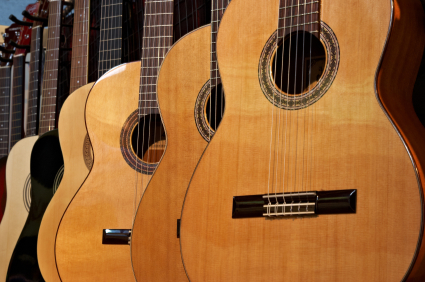
This is the first of a two-part article series by guest author Aaron Schulman.
Have you ever heard someone say, “I’m a hands-on learner,” or, “I have to see it to understand it”? Developmental psychologist Howard Gardner tells us that there are (at least) 7 Multiple Intelligences (learning styles) that affect the way people learn. He theorizes that people develop intellectually within these seven different areas and all cognitive development must be measured using each area. Whether you are the best acoustic guitar player in your town or have trouble holding a tune in a bucket, your children can benefit from music education, building up and growing their different learning style or multiple intelligence capabilities. These Multiple Intelligences (per Gardner) are as follows:
• Linguistic
• Logical-mathematical
• Spatial
• Bodily-kinesthetic
• Musical
• Interpersonal
• Intrapersonal
Linguistic style means using written and oral language to learn. People with strength in this area may learn by reading, note-taking, and listening. Logical-mathematical learners analyze problems. These are people who tend to look at each challenge logically and try to solve it with rational problem-solving skills. Spatial intelligence is using visual and creative thinking in abstract ways (including visual and dimensional learning). Bodily-kinesthetic learning is the ability to coordinate your mind and body to achieve a goal (great athletes could have higher core competencies in these areas). The musical learning style is expressed as ability in patterns, performance, and composition with music literacy. Interpersonal intelligence is the capability of working with and understanding others. Finally, intrapersonal intelligence is having an acute understanding of oneself that sets a standard of living (solid self-awareness skills including strengths and weaknesses).
Each person will develop cognitively within these seven styles of learning. Individuals will have varying degrees of strength in each area. Even children from the same family will invariably have different personalities and learning styles. From many other psychological studies, we know that children’s cognitive development increases at the greatest rate from birth to age seven; and from there it continues to increase more gradually. We also know that we can significantly affect children’s rate of learning with varying stimuli (challenging their development through different learning modalities listed above).
You may be saying to yourself right now, wait a minute – I thought this was an article about playing the acoustic guitar? It is. As it turns out, musical ability and cognitive growth have a very strong bond. One particular stimulus you can use to help your child grow in almost every one of the multiple intelligences is music. As a child learns to play an instrument, they must use several different areas of the brain and several modalities of cognitive learning will develop. In learning to read sheet music, discovering beat and tempo, and using body positioning to play an instrument properly, you can already begin to see a large platform of learning styles utilized.
Scientific studies have also shown that being educated in music leads to higher intelligence in spatial and mathematical development. Specifically, as a child learns patterns, rhythm and pitch, they are actually developing their logical-mathematical reasoning and processing. In teaching your child a musical instrument, you are really helping your child’s brain development in a more well-rounded approach; not to mention the great quality time it provides for parent and child.
(Check out http://serendip.brynmawr.edu/exchange/node/1869 For some great information on Dr. Gottfried Schlaug’s research on music students’ developing greater corpus callosum growth and activity. You will also find studies on what is called the Mozart effect on the development and enhancement of spatial memory for music students.)
Studies show that children are capable of developing rhythm and movement even before they are able to speak. In children as young as twelve months, scientists have noted a marked positive influence when a child listens to and explores music and instruments. Children who learn musical instruments before the age of 7 show a tendency to develop a larger, more robust corpus callosum (the neural network that connects both left and right halves of the brain and helps both halves of the brain to communicate). (See aforementioned website for further information on this study.)
Let’s get more practical:
We’ve discussed what music can do for children in general, but what can it specifically do for your child? For infants to young toddlers, music develops their musical and kinesthetic intelligences as they move their arms and legs to the sounds and discover rhythm. For children about three to seven years of age, learning to play a musical instrument helps develop the neural connections in the left and right brain hemispheres. Older children also benefit cognitively from learning musical instruments. Added to that, older children also develop interpersonal and intrapersonal communication skills when receiving lessons and spending quality time with others, especially a parent or other loved one.
All in all, the benefits your child will receive from learning to play an acoustic guitar or one of many other musical instruments will make it worth doing. And you as a parent will receive as much from the quality time you spend learning with and teaching your child.
Look for Part 2 of this series on Monday, December 19.
About the Author: Aaron Schulman is a husband, father, teacher, and experienced guitarist. He enjoys sharing what he has learned through Psychology education and his research into music, especially acoustic guitars, with his readers on his guitar review site, StrumViews.com. You can read more reviews like one on the Taylor 110e, or several other including Aaron’s “best acoustic guitar for under $1,000” series of reviews.
Sunday Singalong: Winter’s On the Way
Winter doesn’t officially begin until December 22 this year — a mere 3 days before Christmas. This throws my students off every year; when it starts getting cold in November, they tell me that it’s winter (and understandably so). That’s why this song came to be.
As much as I usually dread this season, I’m thinking winter and I are going to get along this year. Now that I work from home almost exclusively, I no longer have a scary highway commute to worry about when there is ice and snow on the ground. I’d much prefer to enjoy the view of a winter wonderland from my window rather than walk in one :)
Are you looking forward to winter this year, or are you hanging on to these last couple weeks of fall for dear life? It’s coming either way, so get out the boots, earmuffs and giant parkas (unless you live somewhere warm, in which case I’m super jealous!).
Friday Fave: The 12 Apps of Christmas

People often ask for my advice when it comes to useful music-related iPad apps. I’ve given my fair share of recommendations, but luckily there are more seasoned iPad users than I who so generously share their knowledge with me!
Fellow music therapist Bonnie Hayhurst is one such iPad expert, and this month she is giving the lowdown on her favorite music-related apps. Her series is called “The 12 Apps of Christmas” and can be found on her blog, The Groovy Garfoose.
Thanks to Bonnie’s posts (she’s currently on day 9), I already have a list going of apps I need to download immediately. My favorite so far is the Apple Camera Connection Kit, which I didn’t even know existed! I have already added that to my Amazon wishlist :)
If you have an iPad that you use for music therapy or other music-related purposes, or if your students or clients use an iPad, this is a series you need to check out. And now I’m off to the app store to do a little window shopping!
Music for a Cause
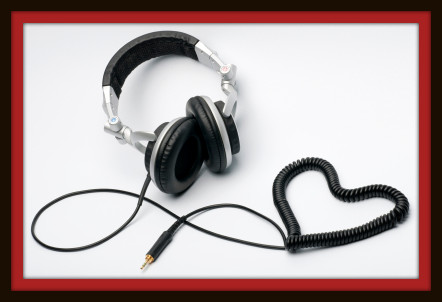
I first learned of a neurological disorder called Agenesis of the Corpus Callosum (ACC) a few years back, when a mother of a child with ACC contacted me to tell me how much her son enjoyed my music. Sandie and I have kept in touch since then, and she writes a wonderful blog that serves as an invaluable resource for the ACC community.
So I was naturally moved to share the note that I received earlier this week from a father of a child with ACC:
Hi, Rachel. I’ve recently recorded an album of songs that was released today and I’m going to give all of the proceeds from sales to the National Organization for Disorders of the Corpus Callosum. My son, Bowie, has ACC and though he’s doing wonderfully, I remember not having many resources to collect on the disorder. Your website was one of the sites that helped my wife and I learn more about how music can help children with ACC. My aim, with this album, is to promote awareness as well as raise funds. I hope you like the music. Thanks so much, Michael Fitch.
I had a chance to listen to a portion of the album, titled Après La Guerre (you can do so on iTunes or CD Baby) and was impressed! It’s not a children’s CD, but many children will benefit as a result of it.
I’m always moved by people who use their talent to help others. That’s why I became a music therapist in the first place. Thank you, Michael, for the work you’re doing, and sharing it with us. For more information, you can visit his blog, Songs-I-Meant-To-Say.

